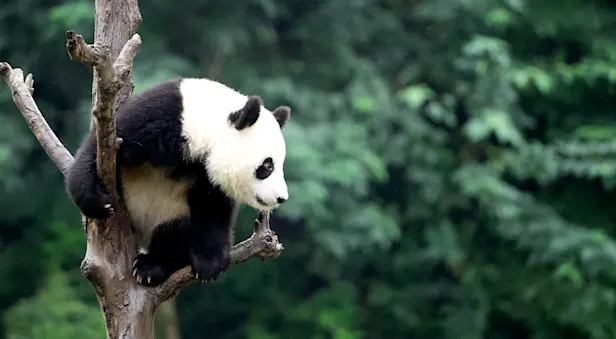
Know Before You Go
Asiatic Black Bear Facts | China Wildlife Guide
Physical Characteristics
Asiatic black bears differ in size between males and females. Males typically weigh 242 to 330 pounds, while females weigh between 143 and 198 pounds. Their head and body measure approximately four to six feet in length, and they have large, rounded heads and small eyes. Their large ears are placed farther apart on their heads than the American black bear. Their body is heavy, with strong, thick legs, and broad paws. Their tail is short, two to four inches in length, and can barely be seen from underneath their long, coarse fur. Their black coat is marked with a light-colored chin and a white, “V”-shaped chest patch, from which their other name, moon bear, derives.
Habitat
Asiatic black bears are found in many Asian countries including China, Japan and Korea. They inhabit broadleaf and coniferous forests, foothills, and mountain regions with thick vegetation. During the summer, they travel to higher elevations, descending to warmer areas in the winter. Periodically, they journey out of the forests to search for food on the plains. The Asiatic black bear can occupy anywhere from 4 to 22 square miles, depending on the available food.
Reproduction
Asiatic black bears start breeding when they are 3 to 4 years old. Like panda bears and red pandas, delayed implantation of the embryo occurs during the first two months, and pregnancy lasts seven to eight months. The mother typically gives birth to two cubs in a hollow tree or rock cavity in winter, with each cub weighing 8 to 10.5 ounces.
Newborn cubs keep their eyes closed during their first week, and are weaned at about three months. Cubs live with their mother until they are two to three years of age.
Behavior & Communication
Asiatic black bears feed at night, sleeping in hollow trees and rock crevices during the day. In the fall, the bears increase their nocturnal activity, descending to lower elevations to forage for foods in broadleaf forests. They are adept climbers and skilled swimmers. They walk on the soles of their four feet, but will stand on their hind legs when fighting, slapping their rival with their forepaws. Asiatic black bears are reclusive, and won’t attack humans unless they are wounded, or they believe their cubs are threatened, though there have been instances of unprovoked attacks.
Many Asiatic black bears hibernate. They forage in the late summer and fall, creating stores of fat for the winter. While some bears hibernate the entire winter, others only sleep when the weather is at its most severe. During hibernation, Asiatic black bears don’t urinate or defecate, eat or move. Their heart rate slows from 40 to 70 beats per minute to between 8 and 12 beats per minute, while their metabolic rate drops by 50 percent.
Asiatic black bears have a keen sense of smell, excellent vision and hearing. While there have been few studies of Asiatic black bears’ communicative behaviors, it can be inferred from studies of others in the Ursidae family that these bears utilize a series of vocalizations. These calls include the cries of cubs when separated from their mother, clicking the teeth together when showing aggression, and producing a low guttural sound when apprehensive.
Bears frequently communicate with one another using visual signals. Dominant bears convey their status by walking or running towards their opponent, while subordinate bears walk away, sit, or lie on the ground. Asiatic black bears also leave scent markings through urination, defecation, and rubbing against trees.
Feeding Habits
Asiatic black bears are omnivorous, though they are primarily vegetarians. They feed on fruits, seeds, grasses, roots, tubers, honey, acorns, mushrooms, insects, small prey and carrion. In the fall, a large portion of their diet is from the nuts of Fagaceae trees, which include beeches and oaks. Their keen sense of smell allows them to seek out insects up to three feet beneath the earth. When food is scarce, these bears will eat anything, including domestic animals and produce, and sometimes even strip the bark off of trees. The bears often risk death by farmers, who kill them to protect their crops and livestock.
Conservation
Deforestation from logging, agriculture, dams, and roadways is threatening the habitat of the Asiatic black bear. Due to the Asiatic black bears’ dependence on seasonal foods, a diversity of habitats is required for them to thrive. Yet habitat fragmentation continues to isolate bear populations; even protected areas do not have the variety of habitats needed to fully support these bears.
See Asiatic Black Bears on These China Adventures

The Wild Side of China: A Nature Odyssey
Discover a side of China most travelers never see on our unique itinerary revealing wild panda habitat, rare wildlife and Chinese nature at its most entrancing—including close-up panda encounters.































